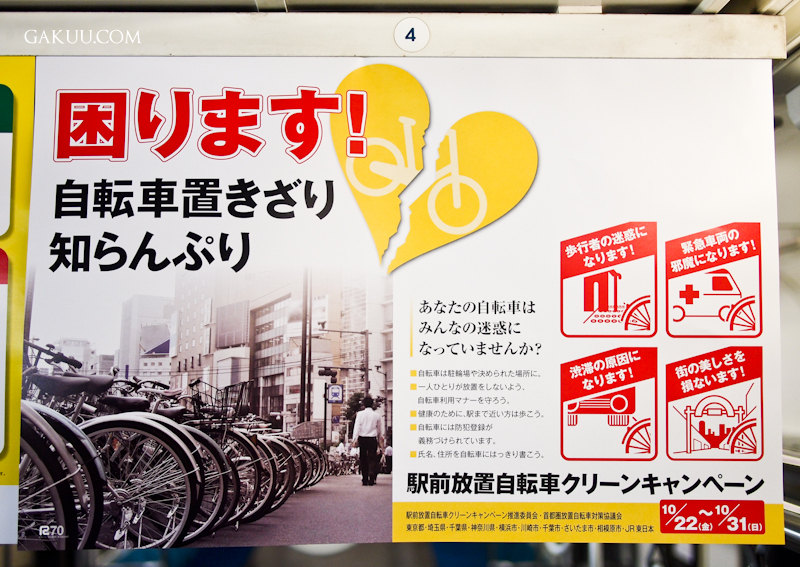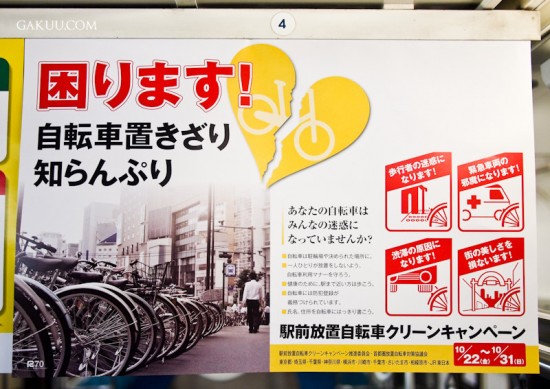Have you ever come across the word ふり before? It’s used in a variety of situations to show pretense or false behaviour. Today’s phrase we’ll focus on then is 知らんぷり – pretending not to know something. You’ll also learn about the mysterious ん slotted in there!
困ります!自転車置きざり、知らんぷり。
こまります! じてんしゃ おきざり、 しらんぷり
First up then, the big word in red – 困ります. To be troubled or inconvenienced by something. In this notice, the emphasis is on the inconvenience, specifically everyone’s inconvenience. The term can sometimes be tricky to interpret as, like many words, there is no one direct translation that fits every sentence. The best thing to do when trying to figure out how best to say the same thing in English is to focus on the feeling of being troubled or inconvenienced. Imagine the same situation happening in an English-speaking country and how you would express those same feelings in a natural way. Consider:
道が分からなくて困った。
みちが わからなくて こまった。
‘I was troubled because I didn’t know the roads’ would certainly get the message across, but it doesn’t sound very smart. Instead we could say ‘I was at a loss for which way to go’ or simply ‘I was lost’. Another similar phrase:
困ったなぁ・・・
こまったなぁ・・・
Would be ‘that’s troubling (for me)’, but it doesn’t sound very natural. This single word is often uttered when somebody is thinking or dwelling on a matter in Japanese – to a certain extent, they are suffering. The extended な (a male equivalent of the particle ね) is used to add emphasis in spoken Japanese. ‘What should we do..?’ or perhaps even just a sigh like ‘Ahh…’ would suffice.
Anyway, back to the sign.
自転車 is ‘bicycle’ and the verb 置く ‘to put’. 置く is combined with 去る – ‘to leave’ or ‘to depart’ making ‘put and leave’ or simply ‘abandoning something’. In this case we understand it means leaving bicycles in such a way that it causes inconvenience. It seems that the notice is trying to kill two birds with one stone, because it isn’t only talking about truly abandoned bicycles, but also bicycles that are temporarily left in places where they shoudn’t be parked.
知らんぷり then is made up of 知る – ‘to know’ and ふり – ‘pretend’. A couple of interesting changes are happening here though, mainly for added emphasis and to make it easier to pronounce.
Firstly ん is used in place of ない – the negative form of the verb. This happens quite often in regional dialects and slang speech and has something of a curt sound to it: 図書館はどこにあるか知ってる? –知らん! (Do you know where the library is? –Nope!) Best to take care when using it and the tone of your voice.
Secondly, ふり becomes ぷり in this case because 知らんぷり is more of a fixed expression (although it is based on the standard usage of ふり). You might think of 知らんぷり as ‘feigned ignorance’, a shortened form of 知らないふりをする – to pretend not to know. A similar phrase 知らん顔 (しらんかお) – an unconcerned face – is used to express the same thing.
A few more examples for reference:
That’s not all! Log in to see the rest of this lesson.
Or if you aren’t a member yet, please consider signing up.


Leave a Reply